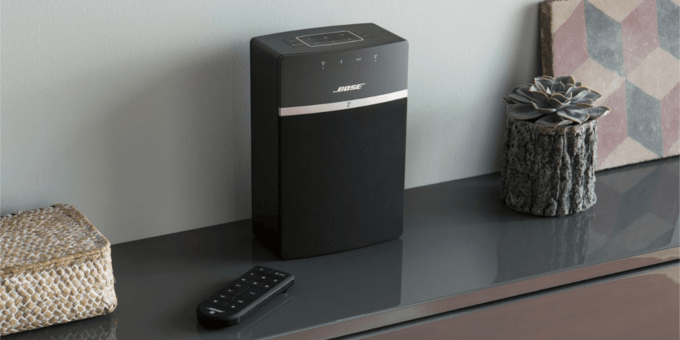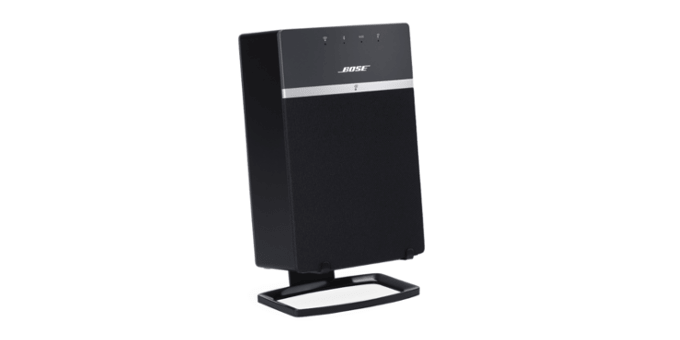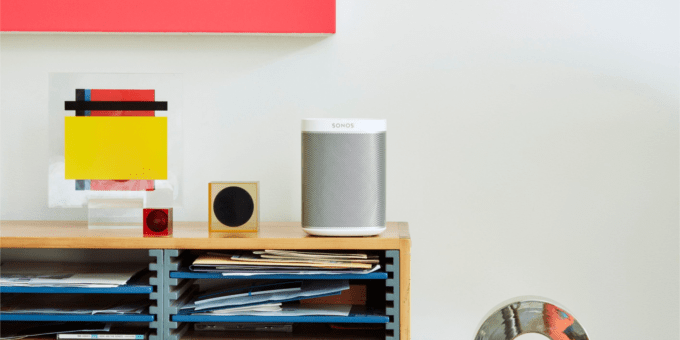When comparing the vs. Bose SoundTouch 10, it can be difficult to wade through all of the technical specifications and various features that each product family has to offer.
The integration with smart home systems and support for an impressive amount of streaming services make the one of the hottest devices on the market, but the Bose SoundTouch 10 has its own charm with more flexible control options that extend beyond what Sonos has to offer.
We’ve compiled the key points you should consider when shopping for a smart speaker so you can buy a smart speaker that is the perfect fit.
Sonos PLAY:1 vs. Bose SoundTouch 10 — Differences
Difference #1: Sound Quality – The Sonos PLAY:1 and Bose SoundTouch 10 both offer some impressive audio quality, but there are some differences in performance based off of the different internal equipment that they use to produce sound.
The Sonos PLAY:1 features two speakers backed up by two Class-D digital amplifiers that provide powerful volume and rich sound. The tweeter and mid woofer help round out the speaker for a sound quality that keeps up with much more expensive devices.
The Bose SoundTouch 10 has a single speaker with no amplifiers, tweeters, or mid woofers. You’ll likely notice a significant difference in sound quality when compared to the PLAY:1 just due to the lack of audio equipment that is necessary to produce a clear, crisp, and dynamic sound.
Difference #2: Adjustable Bass & Treble Controls – For the best possible audio performance, it’s important to be able to adjust the bass and treble as needed to produce a perfect sound that is optimized for the space you are in. The Sonos PLAY:1 gives you the capability to tweak these audio settings at will, while the Bose SoundTouch lacks this feature.
Difference #3: Audio Line-In – Whether you’re hooking up a friend’s phone to play their favorite songs or attaching your speaker to a TV, having an audio line-in is majorly useful and has effects both on the control of the speakers itself as well as the way in which it can interface with other technologies.
The Bose SoundTouch 10 has an audio line-in that allows you to play music or other audio from systems that are not hooked up to your wireless network. This feature is also majorly useful for those who would like to use their speaker a part of a home theater sound system, as a simple auxiliary cord provides the ability to provide your Netflix binge with enhanced audio.
The Sonos PLAY:1, unfortunately, doesn’t have support for an audio line-in. If you’re looking for a smart speaker with that capability within the Sonos family, consider taking a look at the PLAY:5.
Difference #4: Control Options – The Sonos PLAY:1 and Bose SoundTouch 10 vary in the way that they are controlled as well.
Both devices off app control as well as the ability to adjust settings on the speaker itself, but Bose also gives you the option to use a dedicated remote for the SoundTouch 10.
The speakers are both controllable with an Amazon Echo or Echo Dot due to their support for Alexa, but the Bose SoundTouch also offers the ability to control the speaker via Google Assistant through the audio line-in.
Overall, there seem to be more control options with the Bose SoundTouch 10, although it does fall behind in the number of services it supports.
Difference #5: Humidity Resistant – One major benefit of the Sonos PLAY line is their humidity resistance. While you’re not going to want to leave your speaker out in the rain or drop it in a pool, it stands up quite well to basic humidity — giving it more flexibility in placement.
The Bose SoundTouch 10 is not humidity resistant and needs to remain in a dry area at all times.
Difference #6: Trueplay – The Sonos product family supports Trueplay, which is a utility that adjusts audio levels automatically in order to provide the highest-quality sound possible for the room that it’s currently in. Room size, shape, and composition can drastically alter the quality of audio, so having a speaker that takes the guesswork out of the equation and does an admirable job of automatically adjusting is a big part of what sets the Sonos PLAY:1 apart from the SoundTouch 10.
Difference #7: Connectivity – Both the Sonos PLAY:1 and Bose SoundTouch 10 offers support for playing music over WiFi, but they differ slightly in how their connections work.
With the Sonos speaker, it will automatically connect to your home WiFi and create its own, dedicated wireless network called SonosNet. This will allow your speakers to transmit and receive data without any interference from other internet-connected devices — allowing you to stream without any interruption. SonosNet also makes it easy to add and configure additional speakers, making it the premier option for building out a new home audio system.
Bose allows you to connect to speakers and devices through WiFi and Bluetooth. The primary method of communication will always be WiFi, but for those situations that you’d like to play music over a Bluetooth connection — such as streaming music from your phone when you’re not connected to WiFi — the extra feature can be majorly useful.
Difference #8: Supported Services – There are some pretty major differences between the Sonos PLAY:1 and the Bose SoundTouch 10 in terms of the services that they support.
Both smart speakers will play music that is stored on your computer or mobile phone in one way or another, but the PLAY:1 comes out on top when it comes to streaming due to the integration with around 80 online services.
The Bose speaker has some basic support for major apps, but in the majority of cases you won’t be able to stream music quite as easily as you can with the Sonos product families. A potential workaround for this issue is to play music from your favorite apps via bluetooth, but it definitely feels a little more clunky than the built-in WiFi streaming support we see with the Sonos PLAY:1.
It’s important to note that the Sonos PLAY:1 streaming usually only works with the paid or premium versions of apps, so you’ll likely need to subscribe to a service Spotify if you want access to stream without any issues.
Difference #9: Extend to 5.1 Home Theatre Sound System – One of the major benefits of the PLAY:1, when compared to a speaker like the Bose SoundTouch 10, is its ability to be expanded into a 5.1 home theater sound system. In order to take your sound system to the next level, pair the PLAY: 1 with an identical speaker in order to form left and right stereo channels. Adding in a soundbar for the TV like the Beam, Playbar, or Playbase and adding a Sonos Sub for that incredible bass and you’re well on your way to the audio of your dreams.
Unfortunately, the Bose speaker cannot be extended into a full sound system so you’ll be stuck with the capabilities of the SoundTouch 10 by itself.
Sonos PLAY:1 vs. Bose SoundTouch 10 — Comparison Chart
| Bose SoundTouch 10 | ||
|---|---|---|
| Mono Output | Yes | Yes |
| Stereo Output | Yes, with another PLAY:1 | Yes, with another SoundTouch 10 |
| Class-D Digital Amplifiers | 2 | – |
| Drivers/Speakers | 2 | 1 |
| Tweeter | 1 | – |
| Mid-Woofer | 1 | – |
| Adjustable Bass & Treble Controls | Yes | No |
| Audio line-in | No | Yes |
| Connect to TV | No | Via AUX Cord |
| Has its Own Remote | No | Yes |
| Voice Control over Amazon Alexa | Yes | Yes |
| Voice Control Over Siri | No | No |
| Voice Control Over Google Assistant | No | Via line-in port |
| Amazon Alexa Built-In | No | No |
| Trueplay | Yes | No |
| Set Up Over WiFi | Yes | Yes |
| Humidity Resistant | Yes | No |
| WiFi | 802.11b/g, 2.4 GHz | 802.11 b/g/n, 2.4 and 5Ghz |
| Bluetooth | No | Yes |
| Ethernet Port | 1 | No |
| On-Device Control | Button Control | Button Control |
| One App Control | Yes | Yes |
| IR Control | No | Yes |
| Wall Mount | Available | Available |
| Extend to 5.1 | Yes | No |
| Size | Small | Small |
| Dimensions | 6.36 x 4.69 x 4.69 in. (161.45 x 119.7 x 119.7 mm) |
8.34 x 5.56 x 3.43″ (212 x 141 x 87 mm) |
| Weight | 4.08 lbs. (1.85 kg) | 2.89 lbs (1.31 kg) |
| Product finish | White w/ light metallic grille; Black w/ graphite grille |
White/Black |
Sonos PLAY:1 vs. Bose SoundTouch 10 — Things in Common

Mono/Stereo Output – The Sonos PLAY:1 and Bose SoundTouch 10 are both mono speakers by default. However, you can enjoy a rich stereo sound if you pair two of the speakers together. Two PLAY:1 speakers will form left and right channels in order to provide well-rounded audio, and the same can be said for the SoundTouch 10. Just keep in mind that this pairing will only work with identical speakers — so don’t expect to buy one of each!
Set Up Over WiFi – Both the PLAY:1 and SoundTouch 10 are very easy to install as they have support for setup over WiFi. Just connect your speaker to the wireless network and follow the steps through their app in order to get the device online and tweak any important settings.
App Control – The speakers both have mobile control via a dedicated Bose or Sonos app. This allows you to control the music playing without using a dedicated remote or walking over to the speaker itself, and being able to adjust settings and the song playing via your iPhone or Android device is definitely a major perk of the PLAY:1 and Bose SoundTouch 10.
Voice Control over Amazon Alexa – The PLAY:1 and Bose SoundTouch 10 are both smart speakers that can be controlled using the Amazon Alexa virtual assistant. So, if you already have Amazon Echo or Echo Dot, you can use voice commands to change the track or adjust the volume is one of the main reasons why these speakers are so great.
On-Device Button Control – While both speakers offer convenient control through a dedicated mobile app, they also support on-device button control. This allows you to Play/Pause, adjust volume, and skip tracks when you don’t have your phone handy.
Flexible Mount Options – Ease of installation is the name of the game for the Sonos PLAY:1 and Bose SoundTouch 10, and both speakers support a variety of mounting options that provide a near-guarantee you’ll find the perfect way to integrate a smart speaker into your home.
Sonos PLAY:1 and Bose SoundTouch 10 | Integration

The Sonos PLAY:1 works with pretty much any product included in this list of Sonos partners, and you should be able to control the entirety of your smart home — PLAY:1 included — through a smart home management system like Lutron. This integration is part of Sonos’ commitment to allowing you to control everything through one convenient app.
The SoundTouch 10, on the other hand, has significantly fewer partners and will not be as easy to integrate with your smart home setup. It does, however, work with SmartThings, which makes it a good choice for those who are already tied into that hub and its supported products.
Sonos PLAY:1 and Bose SoundTouch 10 | Accessories

The Sonos PLAY:1 and Bose SoundTouch 10 both offer flexible mounting options, so you should be able to find a way to integrate the speaker with the rest of your home with either choice.
The PLAY:1 offers support for a wall and stand mount, as well as compatibility with Sonos Boost — a utility that extends your devices’ WiFi coverage and reduces interference on their dedicated network.
The Bose SoundTouch 10 is equally flexible, with options for wall and stand mounting.
Sonos PLAY:1 vs. Bose SoundTouch 10 — Our Thoughts

At the end of the day, we feel that the is the superior speaker. With better sound quality, extensive integration options, humidity resistance, and the ability to further extend your investment into an entire home theater, it’s difficult to beat.
No products found.
With that said, the Bose SoundTouch 10 is part of a brand that has had a significant following for years with many devotees that praise the quality of sound that the speakers produce. If you’re a fan of Bose, the SoundTouch 10 may be a viable option despite the fewer features and less impressive smart home integration.
Last update on 2024-04-18 at 22:16 / Affiliate links / Images from Amazon Product Advertising API




